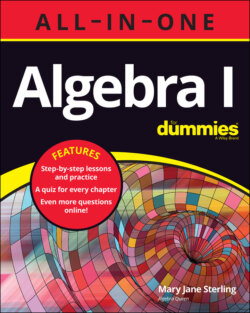Читать книгу Algebra I All-in-One For Dummies - Mary Jane Sterling, Mary Sterling Jane - Страница 64
Making Associations Work
ОглавлениеThe associative property has to do with grouping — that is, how you deal with two or more terms when you perform operations on them. Think about what the word associate means. When you associate with someone, you’re close to the person, or you’re in the same group with them. Say that Anika, Becky, and Cora associate. Whether Anika drives over to pick up Becky and the two of them go to Cora’s house and pick her up, or Cora is at Becky’s house and Anika picks up both of them at the same time, the same result occurs: all three are in the car at the end.
The associative property means that even if a particular grouping of the operation changes, the result remains the same. (If you need a reminder about grouping, refer to the section, “Getting a Grip on Grouping Symbols,” earlier in this chapter.) Addition and multiplication are associative operations. Subtraction and division are not associative. So,
You can always find a few cases where the associative property works even though it isn’t supposed to. For example, in the subtraction problem , the property seems to work. Also, in the division problem , it seems to work. I just picked numbers very carefully that would make it seem like you could associate using subtraction and division. Although there are exceptions, a rule must work all the time, not just in special cases.
Here’s how the associative property works:
This rule is special to addition and multiplication. It doesn’t work for subtraction or division. You’re probably wondering why you would even use this rule. That’s because it can sometimes make the computation easier.
Q. Use the associative property to create an easier problem:
A. With the current grouping, you need to add to 111 and then add the result to 14. Instead, take advantage of the associative property and regroup: . Now you have a resulting problem of — much easier!
Q. Use the associate property to create an easier problem:
A. Regroup, putting the first two numbers together:
13
14
15
16
